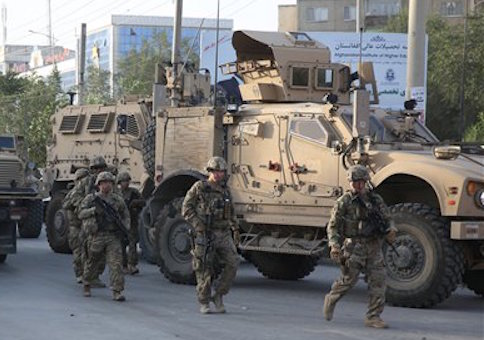President Obama is considering leaving up to 5,000 U.S. troops in Afghanistan beyond 2016, diverging from his initial plan to scale back American forces by the time he leaves the White House.
The new plan was introduced by Gen. Martin Dempsey in August before he stepped down from his post as chairman of the Joint Chiefs of Staff. It centers on U.S. counterterrorism operations against the Islamic State (IS, also known as ISIL or ISIS), al Qaeda, and other groups posing threats to the homeland.
The Washington Post reported:
His plan envisions the United States maintaining a few bases, perhaps two or three, that could be used as "lily pads" to strike groups that posed a direct threat to the United States, senior defense and administration officials said. The "lily pad" bases would potentially house American drones and fighters jets as well as elite counterterrorism troops, and could be located at Bagram Air Base outside Kabul and one or two other airfields, said senior administration officials who spoke on the condition of anonymity to discuss internal planning.
Dempsey’s proposal would involve keeping between 3,000 and 5,000 troops in Afghanistan and is a prong of a larger global counterterrorism plan that has been developed since IS gained territory in Iraq and Syria.
Obama has not yet accepted nor rejected the proposal, but some officials say that the president plans to make a decision on it sometime soon.
U.S. officials have been rethinking the pullback from Afghanistan amid concerns that reducing the troop level too much could result in the Afghan security forces weakening under pressure from the Taliban and other militant groups. Only after American forces withdrew from Iraq in 2011 was the Islamic State able to rise in the Middle East.
Since Dempsey introduced the plan, the Taliban took control of the city of Kunduz. Though U.S. advisers have helped Afghan forces retake most of the city, the incident indicates that Afghan forces may not be strong enough to hold their ground against the Taliban when the U.S. leaves the country.
"Kunduz has caused some people to think we may not need to be hasty. The lesson of Iraq is very much on people’s minds," an anonymous senior military official stated of the pullback from Afghanistan.
While the Obama administration has been focusing on Dempsey’s plan, Gen. John Campbell, the commander of U.S. forces in Afghanistan, has also developed multiple options for leaving forces in Afghanistan beyond 2016, one of which involves keeping 7,000 U.S. troops in the region.
